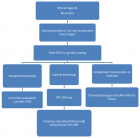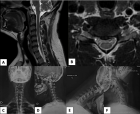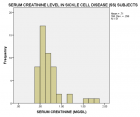Table of Contents
Impact of various PCOS phenotypes on oocyte competence in an ART cycle
Published on: 14th June, 2022
Introduction: PCOS is a common cause of female infertility. Although PCOS patients are characterized by producing an increased number of oocytes, they are often of poor quality, leading to lower fertilization, cleavage, and implantation and higher miscarriage rates.Aims: The present study aims to identify the effect of various PCOS phenotypes on oocyte competence in an ART cycle.Settings and design: A retrospective observational study. Methods and material: The study group included 102 women with PCOS as a main cause of infertility. Data was collected over a period of one year (2017-18). These women were divided into four groups on basis of PCOS phenotypes (A-D) and the relevant clinical data and the ART outcome were noted. Statistical analysis was done using SPSS statistical package. Data presented as mean ± SD which was compared using the ANOVA test. A p - value < 0.05 was considered statistically significant.Results: Out of 102 PCOS women, 23.52% women had phenotype A, 11.76% had phenotype B, and 45.09% and 19.60% had phenotype C & D respectively. Good quality embryos formed (p - value 0.01) were lower in Group B vs. other groups. However, clinical pregnancy rates were comparable in all groups.Conclusion: The reproductive potential of women with PCOS varies with the oocyte health and it largely depends on PCOS phenotype. Women with PCOS phenotype B might have poor IVF/ICSI outcomes with regard to the number of oocytes retrieved and embryos formed. PCO morphology might carry an advantage with regards to the number of oocytes retrieved and better quality embryos. It seems that hyperandrogenism in combination with chronic anovulation is associated with poor oocyte competence and hence, a negative impact on embryo quality and clinical pregnancy rate. Further studies with a larger sample size are required to further support it.Key messages: Oocyte competence in various PCOS phenotypes.
Immunohistochemical expression of p53 and Fox A1 in epithelial ovarian cancer
Published on: 20th May, 2022
Background: Ovarian cancer (OC) is the fifth cause of cancer mortality in females. There were an estimated 300,000 new cases of OC diagnosed worldwide in 2018, corresponding to 3.4% of all cancer cases among women. The high mortality rate of OC attributed to asymptomatic growth of the tumor leads to its diagnosis at advanced stages. About 85% - 90% of OC are epithelial including serous, endometrioid, clear cell, and mucinous carcinoma. Aim: To study the immunohistochemical (IHC) expression of FOXA1 and p53 in epithelial OC and its association with prognostic indicators such as age, tumor size, stage, grade, and histological type.Materials and methods: The study included 52 cases with EOC from the pathology department, faculty of medicine, Aswan, and Sohag Universities, in the period from January 2017 to December 2019. This study involved 52 patients with OC and a median age of 53 years. Different histological types were included as 37 serous, 12 mucinous, 1 case endometroid 2 cases clear cell OC. The study cases were classified into 22 Grade I, 16 Grade II, and 20 Grade III. About 22 cases were at stage I, 9 at stage II, 11 at stage III, and 10 at stage IV. Tissue sections were stained using the IHC technique with FOX A1 at a dilution of 1:100 and p53 at 1:100. Results: A statistically significant correlation was found between FOX A1 expression and advanced patient's age, high grade, advanced stage, ruptured capsule, and ascites, regardless of tumor laterality. No significant association was found between p53 immunoexpression and the same clinic-pathological parameters although p53 was associated with serious type. Conclusion: FOXA1 immunoexpression in EOC is considered a poor prognostic factor in EOC. FOXA1 could be a potential therapeutic target and prognostic marker in EOC.
Factors associated with utilization of Iron with Folic Acid (IFA) supplement among pregnant women attending antenatal care at government health facilities and family guidance clinic in Hawassa City Administration, Hawassa, Ethiopia
Published on: 13th May, 2022
Background: Iron deficiency anemia is common during pregnancy since the overall iron requirement is greater than non-pregnant women and is associated with adverse outcomes. Iron deficiency (ID) is a state of insufficient iron to maintain normal physiological functions of tissues and leads to anemia.Objectives: To assess factors associated with the utilization of Iron with Folic acid supplement Among Pregnant Women Attending Antenatal care at Government Health Facilities and Family Guidance Clinic in Hawassa City, South Ethiopia.Methods: Institutional-based cross-sectional study design was conducted among 412 health providers who are working at public health institutes in Hawassa city from March to April 2015. Pretested Self-administered questionnaires were used to collect the data. The data was entered into Epi-data and analysed by SPSS version 26.0. Bivariate and multivariate regression analysis was used to see the significant association between the outcome and independent variables. Odds ratios and 95% CI will be computed to measure the strength of the association, p - value of ˂ 0.05 will be considered a statistically significant.Results: A total of 412 pregnant women who came to attend ANC at least for the second time were interviewed in seven health facilities. Our study showed that 333 (81%, 95% CI: 77.2 - 84.8) pregnant women reported taking IFA supplements and high compliance was 37.7% (95% CI: 32.5 - 42.9). In multivariable analysis, side effects and low acceptance of the supplement were significantly associated with compliance to IFA supplementation (p < 0.05).Conclusion: There is a relatively better level of compliance towards IFA supplementation compared to other national data. Pregnant women should be counseled regarding how to manage the side effects of IFA supplements during ANC. Further research has to be done on the acceptability of the supplements.
Comparision of intra cervical PGE2 gel and transcervical Foley’s catheter for pre-induction cervical ripening
Published on: 3rd May, 2022
OCLC Number/Unique Identifier: 9497124492
Introduction: Induction of labour is a common obstetric intervention, occurring in approximately 25% of term pregnancies in developing countries. Pharmacological and mechanical methods commonly used are prostaglandin preparations (PGE1 and PGE2) and various intracervical catheters (single or double balloon), respectively.Material and methods: Study was conducted in Siliguri District Hospital, Siliguri, Darjeeling, west Bengal. 100 antenatal woman admitted in obstetrics ward with pog more than 37 weeks were taken for study after applying inclusion and exclusion criteria. 50 were induced with cerviprime gel and 50 with intracervical foley catheter. Statistical analysis done.Results: Mean interval between treatment initiation and delivery was not statistically significant, tachysystole was more common in group B women, rate of LSCS and NVD was similar in both groups.Conclusion: It can be concluded from the present study that Foley’s catheter (mechanical) and prostaglandin E2 gel [pharmacological] both are effective agents for preinduction cervical ripening which substantially improve the bishops score and increase the chances of successful labour induction. There is no significant difference in their efficacy, mode of delivery and perinatal outcome.
Timely initiation of breastfeeding and associated factors among mothers with vaginal and cesarean deliveries in public hospitals of Addis Ababa, Ethiopia
Published on: 21st April, 2022
OCLC Number/Unique Identifier: 9485822018
Background: WHO and UNICEF recommend breastfeeding to be initiated within an hour of birth. However, timely initiation of breastfeeding remains low in Ethiopia. Therefore, this study aimed to compare the timely initiation of breastfeeding and associated factors with cesarean and vaginal deliveries in public hospitals in Addis Ababa, 2021. Methods and materials: Comparative cross-sectional study was conducted from January 2021 to February 2021 in public hospitals of Addis Ababa. 322 mothers within three days of delivery at the postnatal ward of the respective public hospitals were selected. A multi-stage sampling method was employed with the final participants being recruited by systematic random sampling. Data was entered to Epi data Version 4.6 and analysis was performed by SPSS Version 26. A Binary and multivariate logistic regression statistical model was used. Adjusted odds ratio with 95% CI was computed to see the strength of association. Result: Timely breastfeeding initiation was 79 (51.2%) and 123 (80%) for cesarean and vaginal deliveries. With a vaginal delivery, pre-lacteal feeding (AOR = 5.50, 95% CI: 1.83 - 16.57) was significantly associated with timely initiation of breastfeeding. Multiparity (AOR = 2.14, 95% CI: 1.02 - 4.50), support from health care workers (AOR = 2.602, 95% CI: 1.16 - 5.82), and pre-lacteal feeding (AOR = 2.55, 95% CI: 1.13 - 5.75) were significantly associated with timely initiation of breastfeeding with cesarean delivery. Conclusion: The rate of timely initiation of breastfeeding differs according to the mode of delivery. Cesarean delivery, as compared to vaginal delivery, was associated with a lower rate of timely initiation of breastfeeding.
Menstrual cycle effects on sleep
Published on: 5th April, 2022
OCLC Number/Unique Identifier: 9470691728
Sleep and menstrual cycle both are normal physiological processes in women’s life but they are regulated by different centers. Sleep is a daily rhythm whereas the menstrual cycle lasts for 28 days. During this period the estrogen peaks twice. We have shown earlier that there is an inverse relationship between estrogen and the hormone melatonin which aids sleep. Because of this menstruating women will have sleep disorders.

If you are already a member of our network and need to keep track of any developments regarding a question you have already submitted, click "take me to my Query."



















































































































































